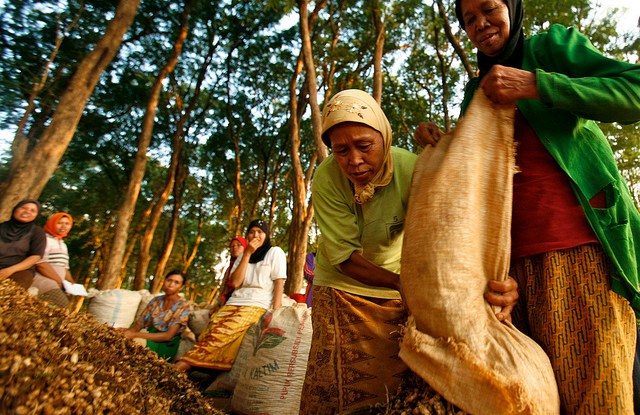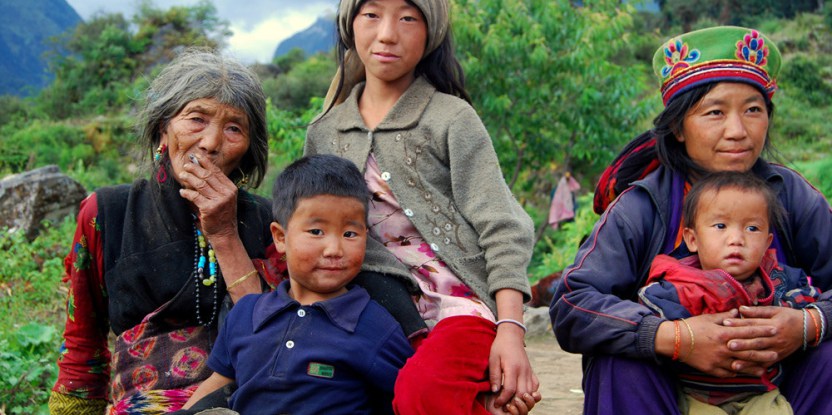
A global study challenges conventional notions of gender roles in forest management, showing that both men and women collect forest products, both for subsistence and for market.
The global study is the product of the Poverty and Environment Network (PEN), a collaborative effort led by the Center for International Forestry Research (CIFOR). The largest quantitative global-comparative research project to date on forests and rural livelihoods, it analyzes data gathered from some 8,000 households in 24 developing countries.
“Challenging perceptions about men, women and forest-product use: A global-comparative study” is one of five initial papers to emerge from the study. The others tackle themes of income generation and rural livelihoods, forests as safety nets, forest clearing and livelihoods, and land tenure and forest income.
The research papers appear in a special issue of World Development journal alongside one PEN case study and six non-PEN studies ranging from micro-level cases to national-level analyses.
DEMYSTIFICATION
“Traditionally, researchers assumed that men were the main contributors to family income, which made any contribution from women invisible,” said Victoria Reyes-Garcia, a co-author and a researcher at the Institute of Environmental Science and Technology-Universitat Autònoma de Barcelona (UAB).
Beginning in the 1970s, she said, researchers “discovered” women’s contributions to household income. In so doing, however, they began to ignore men’s role.
“Contrary to the general perception, men actually played an important subsistence role in the households we were studying,” said Terry Sunderland, a principal scientist with CIFOR.
“The gender debate with respect to the relative roles of men and women has become engrained in the literature. That’s why we were surprised that our data showed men were actually collecting firewood and water, and doing more than their bit for the household.”
“The initial gender equality debate in Western countries was about women,” said co-author Arild Angelsen, an economics professor with the Norwegian University of Life Sciences, who coordinated the global study.
“In other words, gender studies were equated with women’s studies. Increasingly, it is also about men, and their roles at work, at home and in society. Hopefully, we get the same change in the development literature.”
“I remember a village meeting in western Uganda where men complained how stressful their life was compared to women,” he said. “They used to fish in Lake Albert, but were chased away. Then they were involved in forest activities, including pit-sawing, but were chased away. They had begun looking for off-farm work, but it wasn’t easy. Environmental regulations affected them more than women. Where are the studies examining these issues?”
NUANCED VIEW
The global study adds fuel to the gender debate, putting a new perspective on the roles of both men and women, showing that their overall contribution varies across societies.
“Our results, when first presented, created somewhat of a stir because of the size of the dataset and the message it conveyed,” Sunderland said. “It’s nice to be part of something that’s challenging conventional wisdom about how men and women interact with their natural resources.”
The role of demographics, with young people migrating to cities for education and not returning to work on the family farm, is also changing behaviors
According to the study, men and women contribute almost equally to the value of household income from unprocessed forest products such as timber, poles, fruits and mushrooms. This overall finding, however, hides regional differences. In Latin America, for example, men bring about seven times more income from unprocessed forest products to the household than women. The opposite trend occurs in Africa, whereas men and women contribute more equally in Asian sites.
“We have to be careful about generalities,” Sunderland said. “In the literature, you’ll often see a paper titled, ‘Women contribute more to the household.’ Our data show it’s much more nuanced and subtle, and sends a strong and compelling message backed up by substantial evidence.”
REGIONAL VARIATIONS
In Latin America, the data show men are very involved in the commercial production of non-timber forest products such as Brazil nuts. In Africa, women play a stronger subsistence role, while in Southeast Asia men and women tend to share more responsibilities in forest management and agricultural production.
“The commonly held belief that women are the main collectors of forest products seems to hold up only in Africa,” Sunderland said.
Earlier case studies weren’t wrong, he said, only too narrowly focused. Findings from one site, for example, were often extrapolated to make a broad generalization. “With multi-site comparisons, we have a more expansive approach that gives us more confidence in our results.”
Amy Ickowitz, a CIFOR scientist, suggested that earlier studies portrayed a particular portrait of gendered roles because they focused on Africa or southern Asia, where many traditional male-female stereotypes tend to exist.
“Our findings reinforce that women collect firewood and men hunt in these regions,” she said. “But the fact that our data come from diverse regions is why we can show these are not universal gendered patterns, but only stereotypes.”
For Reyes-Garcia, regional differences in the study suggest the relationship of women and women to natural resources is culturally mediated. “For a complete picture of the dependency of any rural society on natural resources, it’s not enough to consider the role of men or women. We need both.”
MARKETS AND GENDER
Another common generalization, said Sunderland, is that men sell products of the highest value, whereas women — if they get to a market at all — are focused on small-scale subsistence products. “In fact, there is incredible regional variation,” he said.
“In Africa, where the markets tend to be more subsistence-oriented, women tend to dominate. In Latin America, which have more specialized markets, men dominate. In Asia, it’s a mixture of the two.”
In this sense, the study reinforces CIFOR research from the mid-2000s that examined how markets drive specialization strategies of people. “It was nice that a conclusive dataset from an earlier CIFOR project fed neatly into our analysis,” he said.
“It shows that general patterns seem to follow regional variations, no matter what lens you look through.”
Will these patterns hold, or will Africa’s markets shift from subsistence to more specialized forest products? If so, will gender patterns of forest use also change? And will cultural differences in gender roles also make a difference?
“We may see markets completely superseded by alternate forms of income, such as remittances,” Sunderland said.
“The role of demographics, with young people migrating to cities for education and not returning to work on the family farm, is also changing behaviors.”
“I don’t see the same type of specialized markets in Latin America developing in Africa, but I may be proven wrong. With climate change and all those uncertainties, anything can happen.”
For more information about the issues in this article, please contact Terry Sunderland, t.sunderland@cgiar.org.
Financial support for the global study was proved by ESRC-DFID, DANIDA, USAID (BASIS-CRSP), IFS and CIFOR.
We want you to share Forests News content, which is licensed under Creative Commons Attribution-NonCommercial-ShareAlike 4.0 International (CC BY-NC-SA 4.0). This means you are free to redistribute our material for non-commercial purposes. All we ask is that you give Forests News appropriate credit and link to the original Forests News content, indicate if changes were made, and distribute your contributions under the same Creative Commons license. You must notify Forests News if you repost, reprint or reuse our materials by contacting forestsnews@cifor-icraf.org.

